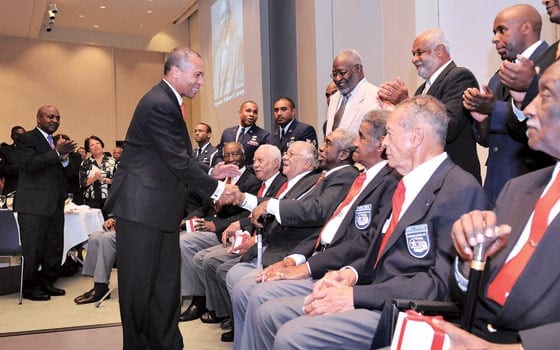
“Red Tails,” the new George Lucas film depicting the valiant Tuskegee Airmen, reminds us of the often overlooked role of African Americans in World War II and their noble achievements. While much has been written about the airmen, very few of us understand how important three women were to their existence. And this is one crucial historical element that Lucas left out.
Since the Civil War, the United States had maintained a Jim Crow Army. While the Navy never deviated from integration, the Army (the Air Force did not become a separate service until after the war) rigidly segregated African Americans into separate units. While African Americans might be effective soldiers, the Army War College in 1925 maintained that “in the process of evolution, the American Negro has not progressed as far as the other subspecies of the human family.” (“Red Tails” opens with a quote from this report.) Blacks, it held, were neither smart enough nor physically strong enough nor brave enough to endure the demands of combat, let alone flight.
Although African Americans had valiantly served in the Civil War, on the frontier in the Indian Wars, in the Spanish American War and in World War I, white politicians and military officers still publicly professed to doubt black ability and patriotism, as part of the ideology and propaganda that undergirded Jim Crow in all of its pernicious forms. The crucial change came in 1938, primarily because of the efforts of an African American woman, Mary McLeod Bethune, who saw, before most other black leaders, a way to break the hold of racism on black participation in the military, by striking at the most resistant obstacle of all: the integration of the pilot program.
Mary McLeod Bethune and Eleanor Roosevelt Open Doors
Bethune’s struggle to get African Americans into pilot-training programs began in 1938 with the New Deal’s Civilian Pilot Training Program. The program was modestly funded by the National Youth Administration (NYA) — an important point, because Bethune headed the “Negro Section” of the NYA. She was also the only female member of President Franklin Delano Roosevelt’s “black cabinet” and a close friend of first lady Eleanor Roosevelt.
Bethune, a famed educator and head of the National Council of Negro Women, proved a relentless advocate for black equality and lobbied President Roosevelt to resist the demands of the Southern wing of the Democratic Party, which was hell-bent on maintaining segregation, especially in the military. Since the program’s goal was to train 20,000 college students a year as civilian pilots, the key to integrating the U.S. Army’s Air Corps during the coming war, Bethune realized, was getting the government to open training programs on the campuses of historically black colleges and universities.
With extraordinary foresight, she used her considerable authority to get Tuskegee Institute, Hampton Institute, Virginia State, North Carolina AandT, Delaware State, West Virginia State and Howard University included among the colleges and universities chosen as sites for pilot training. Without this crucial intervention, there would have been no Tuskegee Airmen.
Beginning in 1939, Bethune advised the president that among all the disabilities black Americans suffered:
“One of the sorest points among Negroes which I have encountered is the flagrant discrimination against Negroes in all the armed forces of the United States. Forthright action on your part to lessen discrimination and segregation and particularly in affording opportunities for the training of Negro pilots for the air corps would gain tremendous good will, perhaps even out of proportion to the significance of such action.”
West Virginia State College became the first black school to establish an aviation program, and because of Bethune’s efforts, it received its first military airplane in 1939. It set a precedent that soon benefited the Tuskegee Institute, which received its authorization in October of that year.
Flying through the open doors: Willa Beatrice Brown
The Tuskegee Airmen also owed a debt to Willa Beatrice Brown, one of two women in the all-black Challenger Air Pilots Association, founded in 1935. Brown was one of about 100 licensed black pilots in the entire country. She also became the first African American woman to receive a commission as a lieutenant in the U.S. Civil Air Patrol.
An expert in business administration and public relations and a dedicated aviator, Brown played a critical role in promoting the image of black aviators to help fight racial prejudice and expand opportunities for all blacks. She became chair of the association’s education committee and appeared in the offices of the Chicago Defender, the famed black paper of the era, to convince the paper to cover the association’s air shows.
Enoch Waters, one of the paper’s editors, visited an air show and became so impressed with the talent he saw that the Defender became a sponsor of the association. The paper, because of Brown’s appeal, also began covering all aspects of black aviation, and soon other black papers followed suit, especially the influential Pittsburgh Courier.
Because several American black aviators had gone to fight the Italian fascists in Ethiopia in 1935, national interest in black pilots had increased. Brown exploited the growing fame of black pilots and helped organize Chicago’s National Airmen’s Association of America in 1937, which chartered branches across the country (except in the Deep South). Without Brown’s work, African-American interest in aviation could have languished.
Additionally, she not only successfully lobbied for federal funds to support the private Coffey School of Aviation in Chicago but also wrote directly to Eleanor Roosevelt in December 1941. Brown’s role in the integration of America’s aviation forces, like that of Bethune, was a considerable one as well.
In 1941 Eleanor Roosevelt, at Bethune’s urging, convinced the Rosenwald Fund (which had a long history of supporting various kinds of projects aimed at ameliorating American race relations, and on whose board she served) to help expand the pilot-training program at Tuskegee. And then in March of that year, Roosevelt not only visited the Tuskegee Institute’s Moton Airfield but, incredibly, also asked the chief flight instructor, Charles A. “Chief” Anderson, to take her on a flight, against the adamant objections of the Secret Service.
This is quite likely the first time a black man flew a plane with a white woman as his passenger. Roosevelt spent over an hour in the skies above Tuskegee. She returned to Washington and lobbied her husband to integrate America’s aviation forces. According to the FDR Presidential Library and Museum, she declared that all the statements she had heard that blacks couldn’t fly planes were bunkum.
The rest is history: The 99th Pursuit Squadron (later called the 99th Fighter Squadron) was formed in July 1941. The first class of black aviator cadets began to train on Nov. 8, 1941, with the first pilots graduating on March 7, 1942. In all, 992 African American pilots trained at Tuskegee Army Air Field, and 450 of its black pilots flew in combat during the war, serving in the four black fighter squadrons and four bomber groups.
By June 1944, black pilots had flown 500 missions in the 99th Fighter Squadron, first in North Africa and later in Sicily and the rest of Italy. The 332nd Fighter Group flew 179 heavy bomber-escort missions, as “Red Tails” depicts so effectively, shielding heavy bombers such as the B-24 Liberator. They shot down 111 Axis aircraft.
In their longest escort mission, the 332nd Fighter group managed to shoot down not one, but three of the new ME-262 jet fighters that the Germans threw against the propeller-driven fighter planes — again, in a battle that Lucas so vividly re-creates. Sixty-six of the Tuskegee Airmen died during the war, and others earned many Purple Hearts, Silver Stars and Distinguished Flying Crosses. President Harry S. Truman even gave the Tuskegee Airmen a Distinguished Unit Citation for “outstanding performance and extraordinary heroism.”
When black activists urged Truman to desegregate the military in 1948, they could point to the heroism of the “Red Tails” pilots to prove that black servicemen had earned the equal treatment that they deserved as loyal Americans. But without the bold imagination of Mary McLeod Bethune, the persistent advocacy of Willa Beatrice Brown and the sheer stubbornness of her friend Eleanor Roosevelt, it is doubtful that Tuskegee Airmen would have come into being.
And while I found the depiction of the relationship between one of the airmen and his Italian fiancée quite touching (in a nod to a similar romance depicted in Spike Lee’s “Miracle at Santa Ana”), it is a pity that the contributions of these three women — two black, one white — couldn’t have been called up to frame the action of this very important film.
Henry Louis Gates Jr. is director of the W.E.B. Du Bois Institute for African and African American Research at Harvard University, and editor-in-chief of The Root.






